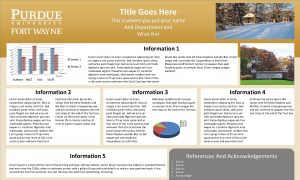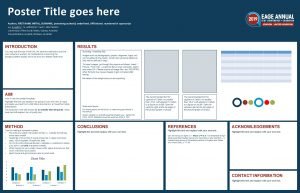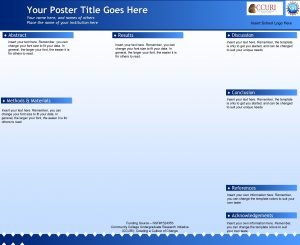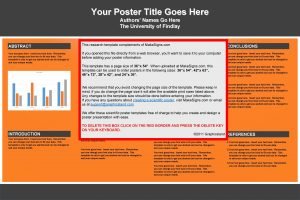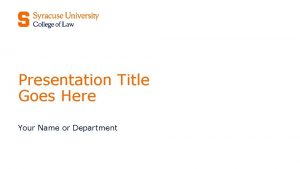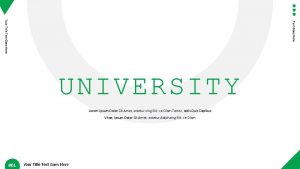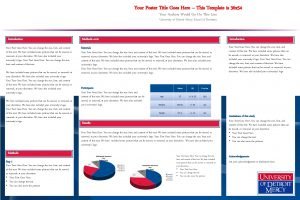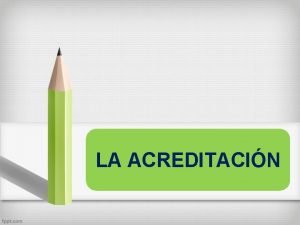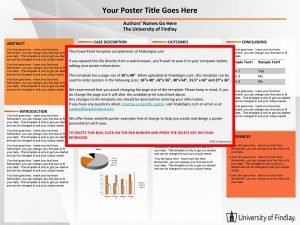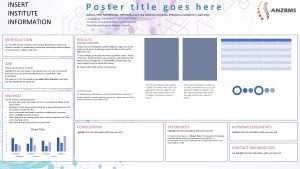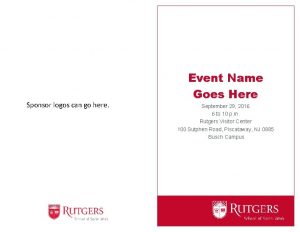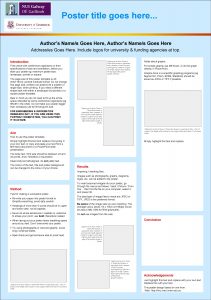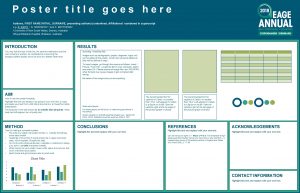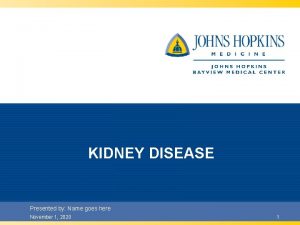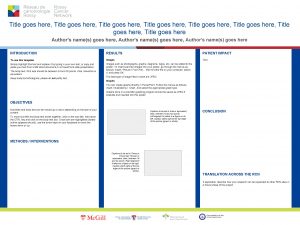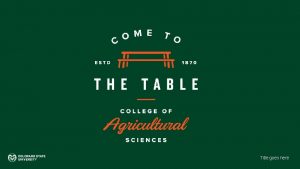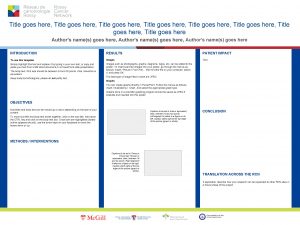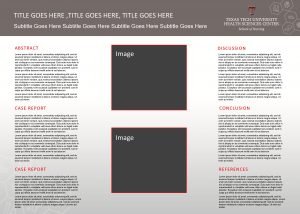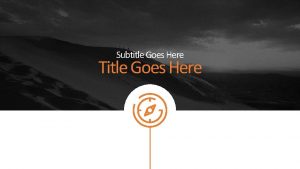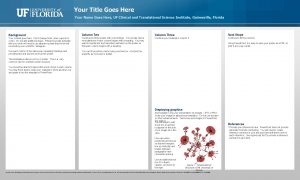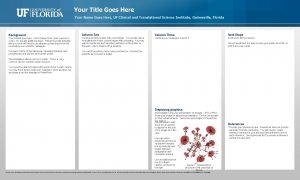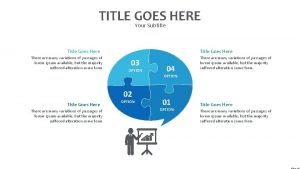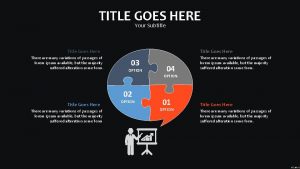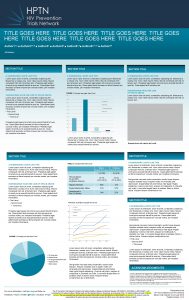Your Title Goes Here Your name and the
















- Slides: 16

Your Title Goes Here Your name and the names of the people who have contributed to this presentation go here. The names and addresses of the associated institutions go here. About this template Using Headings and Textboxes Importing Photographs This template can be modified to fit any poster that is 36 X 48. There is a good deal of clipping that occurs due to the margin limitations of the printer (1/4” top and bottom and. 75” left and right). Copy and Paste heading boxes to create new headings with the same attributes. Drag and drop them to the appropriate locations to meet your needs. They should snap to a location aligned with the edges of the column placeholders. If not, use alignment tools to precisely align left to right with the column placeholders. It is highly recommended to use the largest images you have access to for your poster at least 300 dpi. Avoid low resolution images downloaded from the web and avoid copying and pasting screen resolution images. To insert an image to your poster go to: INSERT>PICTURE>FROM FILE Font Types Our main typeface is Helvetica Neue. It can be used in all instances, including subheads and body copy. When using Helvetica Neue Condensed Black, use it in all caps and only for headlines. Alternate Font: When Helvetica Neue is not available, use Helvetica as a suitable replacement. Type description text within the column placeholders themselves. Add empty paragraphs to allow for placement of heading boxes. Using the Template Color Schemes Please do not adjust the color scheme of the ‘blue and gold’ elements of this template. WVU ‘blue and gold’ are used here for consistency, following the WVU brand color guidelines. Use the top line of colors under “Theme Colors” when choosing fill or text colors from the color dialogues. “Paste Special” also offers more options that will make the resulting images of higher quality. When the only source of a needed photo or graphic is the Web, scaling has to be applied with caution. Scaling an image more than three times its original size may introduce pixelization artifacts. Refer to figure 1 as an example. A simple way to preview the printing quality of an image is to zoom in at 100% or 200%, depending on the final size of the poster. What you’ll see is likely what you’ll get at printing time. Our secondary typeface is Iowan Old Style. Like Helvetica Neue, Iowan Old Style is compelling enough for headlines, and legible enough for large amounts of smaller copy. Importing Tables & Graphs Importing tables, charts and graphs is easier than importing photos. To import charts and graphs from Excel, Word or other applications, go to EDIT>COPY, copy your chart and come back to Power. Point. Go to EDIT>PASTE and paste the chart on the poster. You can scale your charts and tables proportionally by holding down the Shift key and dragging in or out one of the corners (not the sides or middle). 2001 1999 2. Select “Current Page”, if applicable 2003 2005 2006 4. Select “Printer Properties” Labeling your headers Helvetica Neue Condensed Black is our primary typeface for headlines, and should always be set in all caps. Do not use Helvetica Condensed Black for anything other than headlines. Figure 1: Original image at 100%, enlarged 200% and 400%. Accent Palette Use a text size that can be read from 6 feet away. PMS 286 C #0033 A 0 CMYK 100, 75, 0, 0 RGB 0, 51, 160 Helvetica Neue Regular and Helvetica Bold can be used in all instances, including subheads and body copy. PMS 300 C #005 EB 8 CMYK 99, 50, 0, 0 RGB 0, 94, 184 Helvetica Neue Light should not be reversed out onto color or photography to ensure legibility. PMS 7554 C #4 B 3 D 2 A CMYK 37, 53, 68, 81 RGB 75, 61, 42 Iowan Old Style should be used for more formal or academic communications. In cases of complex hierarchies, Iowan Old Style can be combined with Helvetica. Like Helvetica, Iowan Old Style is compelling enough for headlines, and legible enough for large amounts of smaller copy. Remove, Rename, Copy or move these as needed Primary Palette PMS 629 C #9 BD 3 DD CMYK 36, 0, 9, 0 RGB 155, 211, 221 PMS 7557 C #9 F 7 D 23 CMYK 11, 31, 100, 37 RGB 159, 125, 35 PMS 144 C #ED 8 B 00 CMYK 0, 51, 100, 0 RGB 237, 139, 0 PMS 7476 C #0 D 5257 CMYK 89, 22, 34, 65 RGB 13, 82, 87 PMS 5625 C #708573 CMYK 46, 18, 44, 37 RGB 112, 133, 115 PMS 558 C #9 ABEAA CMYK 36, 3, 28, 4 RGB 154, 190, 170 PMS 180 C #BE 3 A 34 CMYK 3, 91, 86, 12 RGB 190, 58, 52 WVU blue #002855 (RGB 0 -40 -85) PMS 295 -C WVU gold #EAAA 00 (RGB 234 -170 -0) PMS 124 -C Tips for Posters PMS 166 C #E 35205 CMYK 0, 76, 100, 0 RGB 227, 82, 5 PMS 115 C #FDDA 24 CMYK 0, 6, 87, 0 RGB 253, 218, 36 Zoom presentation up to 100% or bigger to make sure that these yellow section bars are centered and where you want them. Turn on the ‘gridline's’ under the view menu to help you with spacing. Turn off redline underlines for misspelled words: Go to Power. Point options under Edit or on the ‘office jewel’ on Office 2007. Look for spell as you go and turn that off. Printing proofs on Biz. Hub 3. Select “Fit to Page” or “Scale to Fit Paper” 2004 Alternate Font: When Iowan Old Style is not available, Times New Roman is a suitable replacement. http: //it. wvu. edu/services/labs/printing/bigprints 1. From Power. Point, select “Print” 2000 2002 Take to a Big Prints! Location on campus: If your desktop computer is set up to print to the Biz. Hub (1621 -minoltac 452 on HSPRINT 3), you may print 8. 5” x 11”, 8. 5” x 14”, or 11” x 17” color proofs or handouts from your computer. TABLE ONE 1998 How to prepare your poster for printing The gold with blue lettered headers are used to identify and separate the main topics of your presentation. The most commonly used headers in poster presentations are: Introduction, Summary or Abstract Conclusion Materials and Methods Literature Cited Results Acknowledgements 5. On the “My Tab” tab, select “Paper Size” and choose the size you require (8. 5” x 11”, 8. 5” x 14”, or 11” x 17”) 6. Click “OK” and “Print” Using Slides There are 7 pre-made layouts in the following slides. Choose whichever layout best matches your data. You may change the layout depending on what you want to present, but please do so in keeping with theme of this design. Remember that clipping occurs when printing, so stay within the afore mentioned limits. • Slide #2 Has five columns that are 9” X 29. 56’ • Slide #3 Has 4 columns that are 11. 32” X 29. 56” • Slide #4 Has 3 columns that are 15. 10” X 29. 56” • Slide #5 Has 2 columns that are 22. 77” X 29. 56” Assorted Tips To make a block of text take more or less space on the poster: FORMAT>LINE SPACING (don’t overdo it!) You can modify pasted objects, such as charts from Excel or objects drawn in other programs, by ungrouping them by going to DRAW menu and selecting UNGROUP. You may have to UNGROUP several times. If pasted as a picture, an object is not editable in Power. Point. To accurately align or evenly distribute objects within specified area, select the objects you want to align or distribute and go to the DRAW menu and select ALIGN OR DISTIBUTE. • Slide #6 Has 2 columns one that is 27. 66” X 29. 56” 18. 15” X 29. 56” • Slide #7 Has 2 columns one that is 18. 15” X 29. 56” 27. 66” X 29. 56” • Slide #8 Has no columns. If you use this, content should be centered and cover no more area than 46. 06” X 29. 56” • Gutters between columns are either. 25” or. 26”








Your Title Goes Here Your name and the names of the people who have contributed to this presentation go here. The names and addresses of the associated institutions go here. About this template Using Headings and Textboxes Importing Photographs This template can be modified to fit any poster that is 36 X 48. There is a good deal of clipping that occurs due to the margin limitations of the printer (1/4” top and bottom and. 75” left and right). The actual amount of printable space that can be printed is 46. 5” wide by 35. 5” high, represented by the gray frame in this slide. Test to see if your images are within these limitations by pasting the gray frame over your finished poster. Copy and Paste heading boxes to create new headings with the same attributes. Drag and drop them to the appropriate locations to meet your needs. They should snap to a location aligned with the edges of the column placeholders. If not, use alignment tools to precisely align left to right with the column placeholders. It is highly recommended to use the largest images you have access to for your poster at least 300 dpi. Avoid low resolution images downloaded from the web and avoid copying and pasting screen resolution images. To insert an image to your poster go to: INSERT>PICTURE>FROM FILE There is a version without the MBRCC picture in the top right by right clicking the slide and going to layout and selecting the version without the picture. Font Types Primary Font: Goudy is WVU’s official typeface. Using Goudy helps ensure a consistent appearance for all WVU communications. Other typefaces may be used, however. Times or (Times Roman) makes a good substitute. Type description text within the column placeholders themselves. Add empty paragraphs to allow for placement of heading boxes. Using the Template Color Schemes Please do not adjust the color scheme of the ‘blue and gold’ elements of this template. WVU ‘blue and gold’ are used here for consistency, following the WVU brand color guidelines. Use the top line of colors under “Theme Colors” when choosing fill or text colors from the color dialogues. “Paste Special” also offers more options that will make the resulting images of higher quality. When the only source of a needed photo or graphic is the Web, scaling has to be applied with caution. Scaling an image more than three times its original size may introduce pixelization artifacts. Refer to figure 1 as an example. A simple way to preview the printing quality of an image is to zoom in at 100% or 200%, depending on the final size of the poster. What you’ll see is likely what you’ll get at printing time. Secondary Font: Helvetica works well with Goudy as a secondary typeface, and in applications where Goudy may not be desirable. Arial is a good substitute for Helvetica. Importing Tables & Graphs Importing tables, charts and graphs is easier than importing photos. To import charts and graphs from Excel, Word or other applications, go to EDIT>COPY, copy your chart and come back to Power. Point. Go to EDIT>PASTE and paste the chart on the poster. You can scale your charts and tables proportionally by holding down the Shift key and dragging in or out one of the corners (not the sides or middle). TABLE ONE • Slide #3 Has 4 columns that are 11. 32” X 29. 56” If you need other colors within your text or presentation. This secondary palette is recommended: #ffffcc light gold (RGB 255 -204 -102) #99 CCFF light blue (RGB 153 -204 -255) #CC 0000 red (RGB 204 -0 -0) #9999 CC darker grey (RGB 153 -204) #6600 CC purple (RGB 102 -0 -204) #CCCCFF light grey (RGB 204 -255) #339900 green (RGB 51 -153 -0) Tertiary Palette: Should only be used as accents or for small elements • Slide #4 Has 3 columns that are 15. 10” X 29. 56” • Slide #5 Has 2 columns that are 22. 77” X 29. 56” • Slide #6 Has 2 columns one that is 27. 66” X 29. 56” 18. 15” X 29. 56” • Slide #7 Has 2 columns one that is 18. 15” X 29. 56” 27. 66” X 29. 56” • Slide #8 Has no columns. If you use this, content should be centered and cover no more area than 46. 06” X 29. 56” • Gutters between columns are either. 25” or. 26” Printing proofs on Biz. Hub 1999 2000 1. From Power. Point, select “Print” 2001 2002 2003 2. Select “Current Page”, if applicable 2005 3. Select “Fit to Page” or “Scale to Fit Paper” 2006 4. Select “Printer Properties” Primary Palette #003366 WVU blue (RGB 0 -51 -102) PMS 286 #FFCC 00 WVU gold (RGB 255 -204 -0) PMS 124 • Slide #2 Has five columns that are 9” X 29. 56’ It takes about an hour to print a poster, so please plan ahead. Also, please alert Joel or Lori a day or two ahead of time that you are intending to use the plotter. 1998 2004 Figure 1: Original image at 100%, enlarged 200% and 400%. Choose whichever layout best matches your data. You may change the layout depending on what you want to present, but please do so in keeping with theme of this design. Remember that clipping occurs when printing, so stay within the afore mentioned limits. The plotter is not on the network. Poster files will have to be brought to the poster printer computer on a flash stick or emailed to yourself and downloaded via web email. If your desktop computer is set up to print to the Biz. Hub (1621 -minoltac 452 on HSPRINT 3), you may print 8. 5” x 11”, 8. 5” x 14”, or 11” x 17” color proofs or handouts from your computer. Labeling your headers Remove, Rename, Copy or move these as needed Using Slides There are 7 pre-made layouts in the following slides. How to prepare your poster for printing #AABBCC Grey (RGB 170 -187 -204) #E 0 E 0 E 0 Taupe ( RGB 224 -224) This is used for color around the columns on this poster #99 CCFF cornflower blue (RGB 153 -204 -255) #E 6 B 333 accent to WVU GOLD (RGB 230 -17951) #3399 FF Blue (RGB 51 -153 -255) #715 B 00 Brown (RGB 113 -91 -0) #336699 blue (RGB 51 -102 -153) Tips for Posters Use a text size that can be read from 6 feet away. Zoom presentation up to 100% or bigger to make sure that these yellow section bars are centered and where you want them. Turn on the ‘gridline's’ under the view menu to help you with spacing. Turn off redline underlines for misspelled words: Go to Power. Point options under Edit or on the ‘office jewel’ on Office 2007. Look for spell as you go and turn that off. The gold with blue lettered headers are used to identify and separate the main topics of your presentation. The most commonly used headers in poster presentations are: Introduction, Summary or Abstract Conclusion Materials and Methods Literature Cited Results Acknowledgements Assorted Tips To make a block of text take more or less space on the poster: FORMAT>LINE SPACING (don’t overdo it!) You can modify pasted objects, such as charts from Excel or objects drawn in other programs, by ungrouping them by going to DRAW menu and selecting UNGROUP. You may have to UNGROUP several times. If pasted as a picture, an object is not editable in Power. Point. To accurately align or evenly distribute objects within specified area, select the objects you want to align or distribute and go to the DRAW menu and select ALIGN OR DISTIBUTE. 5. On the “My Tab” tab, select “Paper Size” and choose the size you require (8. 5” x 11”, 8. 5” x 14”, or 11” x 17”) 6. Click “OK” and “Print”







